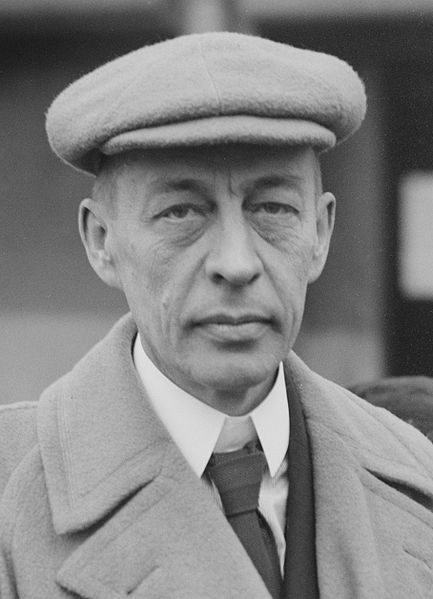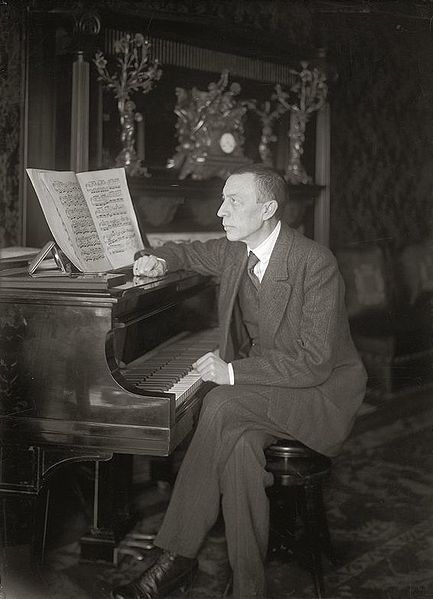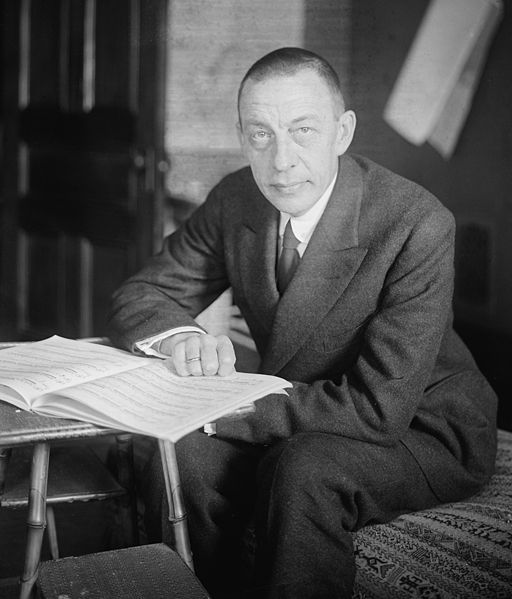<Back to Index>
- Mathematician Marie-Sophie Germain, 1776
- Composer Sergei Vasilievich Rachmaninoff, 1873
- First Chancellor of the German Empire Otto von Bismarck, 1815



Sergei Vasilievich Rachmaninoff (Russian: Сергей Васильевич Рахманинов, 1 April 1873 [O.S. 20 March] – 28 March 1943) was a Russian-American composer, pianist, and conductor. He was one of the finest pianists of his day and, as a composer, very nearly the last great representative of Russian late Romanticism in classical music. Early influences of Tchaikovsky, Rimsky-Korsakov and
other Russian composers gave way to a thoroughly personal idiom which
included a pronounced lyricism, expressive breadth, structural
ingenuity and a tonal palette of rich, distinctive orchestral colors. The
piano features prominently in Rachmaninoff's compositional output,
either as a solo instrument or as part of an ensemble. He made it a
point to use his own skills as a performer to explore fully the
expressive possibilities of the instrument. Rachmaninoff was born in 1873 in Semyonovo, near Novgorod, in north-western Russia. He was born into a noble family of Tatar descent,
who had been in the service of the Russian tsars since the 16th
century. His parents were both amateur pianists. When he was four, his
mother gave him casual piano lessons, but it was his paternal grandfather, Arkady Alexandrovich Rachmaninoff, who brought Anna Ornatskaya, a teacher from Saint Petersburg,
to teach Sergei in 1882. Ornatskaya remained for "two or three years",
until the family home had to be sold to settle debts and the
Rachmaninoffs moved to Moscow. Sergei studied at the Saint Petersburg Conservatory before moving alone to Moscow to study piano under Nikolai Zverev and Alexander Siloti (who was his cousin and a former student of Franz Liszt). He also studied harmony under Anton Arensky and counterpoint under Sergei Taneyev.
Rachmaninoff was found to be quite lazy, failing most of his classes,
and it was the strict regime of the Zverev home that instilled
discipline in the boy. In his early years, he showed great skill in composition. While still a student, he wrote the one-act opera, Aleko, for which he was awarded a gold medal in composition, his First Piano Concerto, and a set of piano pieces, Morceaux de Fantaisie (Op. 3, 1892), which includes the famous Prelude in C sharp minor.
The composer later became annoyed by the public's fascination with this
piece, composed when he was 20 years old. He would often tease an
expectant audience in the days when it was traditional for the audience
to request particular compositions, by asking, "Oh, must I?" or
claiming inability to remember anything else. In Moscow, he met composer Pyotr Ilyich Tchaikovsky,
who became an important mentor and commissioned the teenage
Rachmaninoff to arrange a piano transcription of the suite from his ballet The Sleeping Beauty.
This commission was first offered to Siloti, who declined, but instead
suggested Rachmaninoff would be more than capable. This alternative was
accepted; Siloti supervised the arrangement. Rachmaninoff
confided in Zverev his desire to compose more, requesting a private
room where he could compose in silence. Zverev saw him only as a
pianist and severed his links with the boy, refusing even to speak to
him for three years. Rachmaninoff moved out and continued to compose. The sudden death of Tchaikovsky in 1893 made a strong impression on Rachmaninoff; he immediately began writing a second Trio élégiaque to his memory, clearly revealing the depth and sincerity of his grief in the music's overwhelming aura of gloom. His First Symphony (Op. 13, 1896) premiered on 27 March 1897 in one of a long-running series of "Russian Symphony Concerts". The horrific reception, two disastrous visits to writer Leo Tolstoy's estate and Rachmaninoff's distress over the Russian Orthodox Church's objection to his marrying his cousin, Natalia Satina, contributed to a period of severe depression that lasted three years, during which he wrote virtually no music. One stroke of good fortune came from famous Russian industrialist and patron of the arts Savva Mamontov,
who two years earlier had founded the Moscow Private Russian Opera
Company. He offered Rachmaninoff the post of assistant conductor for
the 1897-8 season, which the cash-strapped composer accepted. He also
met the bass Feodor Chaliapin through Mamontov's opera company, starting what would become a long, deep friendship. In 1900, Rachmaninoff began a course of autosuggestive therapy with psychologist Nikolai Dahl, himself an amateur musician. Rachmaninoff quickly recovered confidence and overcame his writer's block. A result of these sessions was the composition of Piano Concerto No. 2 (Op.
18, 1900–01), dedicated to Dr. Dahl. The piece was very well received
at its premiere, at which Rachmaninoff was soloist. Rachmaninoff's
spirits were further bolstered when, after years of engagement, he was
finally allowed to marry Natalia. They were married in a suburb of Moscow by an army priest on
29 April 1902, using the family's military background to circumvent the
church. Although he had an affair with the 22-year-old singer Nina Koshetz in 1916, his
and Natalia's union lasted until the composer's death. A lesser-known
fact is that Rachmaninoff had another outstanding singer
protégée. In 1911, at the request of Alexander Ossovsky,
Rachmaninoff auditioned, in Kiev, Ossovsky's cousin, young Ksenia Derzhinskaia (1889–1951) and helped to launch her operatic career. She became an eminent singer and prima donna of the Bolshoi Theatre in Moscow. After several successful appearances as a conductor, Rachmaninoff was offered a job as conductor at the Bolshoi Theatre in 1904, although political reasons led to his resignation in March 1906, after which he stayed in Italy until July. He spent the following three winters in Dresden, Germany, intensively composing, and returning to the family estate of Ivanovka every summer. Rachmaninoff made his first tour of the United States as a pianist in 1909, an event for which he composed the Piano Concerto No. 3 (Op.
30, 1909) as a calling card. This successful tour made him a popular
figure in America. Nevertheless, he loathed the tour and declined
offers of future American concerts. The death in 1915 of Alexander Scriabin,
who had studied with him under Zverev, affected Rachmaninoff so deeply
that he went on a tour giving concerts exclusively devoted to
Scriabin's music. When asked to play some of his own music, he would
reply, "Only Scriabin tonight." The 1917 Russian Revolution meant
the end of Russia as the composer had known it. With this change
followed the loss of his estate, his way of life, his livelihood and
essentially his world. On 22 December 1917, he left St. Petersburg for Helsinki with
his wife and two daughters on an open sled, having only a few notebooks
with sketches of his own compositions and two orchestral scores, his
unfinished opera Monna Vanna and Nikolai Rimsky-Korsakov's opera The Golden Cockerel. He spent a year giving concerts in Scandinavia while
also laboring to widen his concert repertory. Near the end of 1918, he
received three offers of lucrative American contracts. Although he
declined all three, he decided the United States might offer a solution to his financial concerns. He departed Kristiania (Oslo) for New York on 1 November 1918. Once there, Rachmaninoff quickly chose an agent, Charles Ellis, and accepted the gift of a piano from Steinway before playing 40 concerts in a four-month period. At the end of the 1919-20 season, he also signed a contract with the Victor Talking Machine Company.
In 1921, the Rachmaninoffs bought a house in the United States, where
they consciously recreated the atmosphere of Ivanovka, entertaining
Russian guests, employing Russian servants, and observing Russian
customs. Due
to his busy concert career, Rachmaninoff's output as composer slowed
tremendously. Between 1918 and his death in 1943, while living in the
U.S. and Europe, he completed only six compositions. This was partly
due to spending much of his time performing in order to support himself
and his family, but the main cause was homesickness. It was during
these years that he traveled the United States as a touring pianist. When
he left Russia, it was as if he had left behind his inspiration. His
revival as composer became possible only after he had built himself a
new home, Villa Senar on Lake Lucerne, Switzerland,
where he spent summers from 1932 to 1939. There, in the comfort of his
own villa which reminded him of his old family estate, Rachmaninoff composed the Rhapsody on a Theme of Paganini, one of his best known works, in 1934. He went on to compose his Symphony No. 3 (Op. 44, 1935–36) and the Symphonic Dances (Op. 45, 1940), his last completed work. Eugene Ormandy and the Philadelphia Orchestra premiered the Symphonic Dances in 1941 in the Academy of Music. In late 1940 or 1941 he was approached by the makers of the British film Dangerous Moonlight to write a short concerto-like piece for use in the film, but he declined. The job went to Richard Addinsell and the orchestrator Roy Douglas, who came up with the Warsaw Concerto. Rachmaninoff fell ill during a concert tour in late 1942 and was subsequently diagnosed with advanced melanoma. The family was informed but the composer was not. His last recital, given on 17 February 1943 at the Alumni Gymnasium of the University of Tennessee in Knoxville, included Chopin's Piano Sonata No. 2, which contains the famous Marche funèbre (Funeral
March). A statue called "Rachmaninoff: The Last Concert", designed and
sculpted by Victor Bokarev, now stands in World Fair Park in Knoxville
as a permanent tribute to Rachmaninoff. He became so ill after this
recital that he had to return to his home in Los Angeles. Rachmaninoff died of melanoma on 28 March 1943, in Beverly Hills, California, just four days before his 70th birthday. A choir sang his All Night Vigil at his funeral. He had wanted to be buried at the Villa Senar, his estate in Switzerland, but the conditions of World War II made fulfilling this request impossible. He was therefore interred on 1 June in Kensico Cemetery in Valhalla, New York.